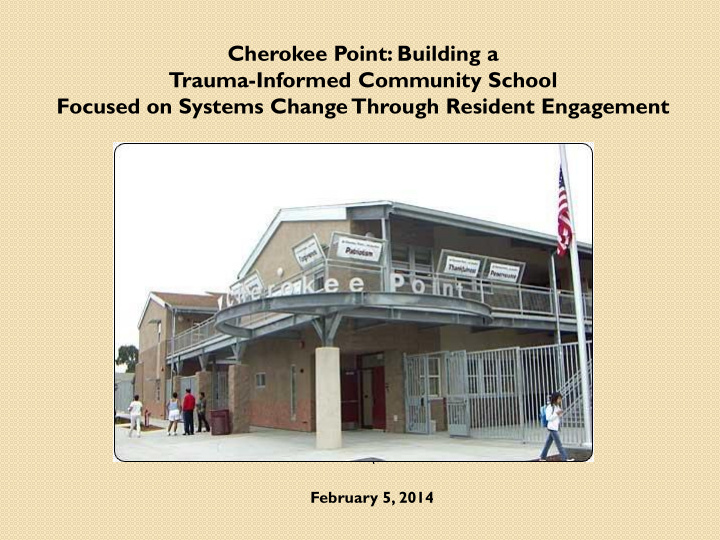



Cherokee Point: Building a Trauma-Informed Community School Focused on Systems Change Through Resident Engagement \ February 5, 2014
Targets for Change through the Trauma Informed Community Schools: A Multi-Systemic Approach to Building Healthy Communities Through Resident Engagement in Systems Change 2011-2014 School Climate & Prevention Resident Youth Health & Engagement & Development Wellness Systems & Leadership Access Change Restorative Justice & Restorative Practices Wellness and Restorative Practices Partnership, funded by The California Endowment, in collaboration with San Diego State University and Cherokee Point Elementary School
Resident Leadership Parents leading parent workshops Parent Leadership Academy Community Union meetings and Family Community nights Parents learning computer and English skills while volunteering for school and socializing with other parents
SYSTEM IMPACT Community Violence and Cumulative Trauma in City Heights (San Diego) Poverty Child Abuse Domestic Violence Gang and Gun Violence Lack of Access to Physical and Behavioral Healthcare Traumas Involving Community Agencies and Systems (e.g., Schools, Child Welfare Services, Law Enforcement, Courts, Immigration) http://nlyingst.iweb.bsu.edu/edpsy251/courseco ncepts/251/bronfenbrenner.html Cherokee Point and City Heights Residents have experienced a lot of acute, chronic, complex and system-induced traumas Training provided by San Diego Trauma-Informed Guide Team
Long-T erm Consequences: Adverse Childhood Experiences-ACE Study Adverse Childhood Experiences under the age of 18 predict physical, behavioral and emotional health in adults http://acestudy.org/
Understanding trauma effects on learning and behaviors Trauma Symptoms - Heightened Arousal • fears and anxieties • startles and hypervigilance • sleeping problems (nightmares) • overreactivity, anger outbursts, and irritability • overcontrolling , “grown up”, excessively responsible behaviors Avoidance (Dissociative and Depressive Symptoms) • withdrawal, passivity, and non-responsiveness • emotional numbing • memory and concentration problems • denial and somatic complaints Trauma effects on children interfere with their T eachers may describe them as: development of social-emotional and behavioral skills Spacey or zoned out needed to learn and thrive in the classroom • Disrespectful or rude • Attention and Information Processing • Lacking intelligence • Executive Functions: Planning and Problem- • solving “Out of control” • Attentiveness to Classroom Tasks Anxious • • Emotional Regulation Annoying • • Aggression, Impulsivity, and Reactivity Aggressive • •
T en Principles of a Compassionate School Focus on culture and climate in the school and community. 1. Train and support all staff regarding trauma and learning. 2. Encourage and sustain open and regular communication for all. 3. Develop a strengths based approach in working with students and 4. peers. Ensure discipline policies are both compassionate and effective 5. (Restorative Practices). Weave compassionate strategies into school improvement planning. 6. Provide tiered support for all students based on what they need. 7. Create flexible accommodations for diverse learners. 8. Provide access, voice, and ownership for staff, students and community. 9. 10. Use data to: ◦ Identify vulnerable students, and ◦ Determine outcomes and strategies for continuous quality improvement. Trauma Informed Support within the School Setting T eaching Students Helping children build a sense of control Helping children regulate emotions in order to • • over their environment master social and academic skills Building on strengths Maintaining high academic standards • • Understanding the connection between Helping children feel safe • • behavior and emotion Managing behavior and setting limits • Avoiding labels • Reducing bullying and harassment • http://www.massadvocates.org/download-book.php •
TRAUMA INFORMED AND COMPASSIONATE PRACTICES USED AT CHEROKEE POINT Employ an empowerment model to elicit and build on strengths: Resident and youth leaders actively leading systems change Listening to Staff, Parents and Students Identifying needs of teachers and staff through consultation and needs assessment Identifying needs of parents with 6 months of Family community night focus groups How Parents Can Help Their Children with Homework Relaxation and Health Promotion Activities for Parents Positive Discipline and Parenting Tips How to Communicate with T eachers about Children’s Progress Better Communication at Home How to Support their Child as a Leader in the Home, School, and Community How to Help Their Children Succeed in School and Prepare for College Addressing Language and Behavioral Problems in Young Children Coping with Domestic Violence Community Safety Youth Leaders identify social justice concerns they want to address • Bullying and School Safety Domestic Violence Drugs/Drinking Gang Violence Homelessness Building Resident/Parent and Youth Leadership: Empowers, Builds on Strengths and Resilience
TRAUMA INFORMED PRACTICES USED AT CHEROKEE POINT Partnering with Residents and Youth: Relational Collaboration • Active Parent Leadership as Evidenced by Community Union, PTA, Leadership Academy, and other leadership opportunities • Principal’s Chat brings community partners to school to guide and educate residents Designing an environment that ensures safety, respect, and acceptance • Cherokee Point Elementary was honored at the March SD Unified School District Board meeting and received the district-wide award for its exemplary work in High Quality Indicator 12: Supportive Environment, Safe and Well Maintained facilities • Examples of activities supporting an environment that promotes a culture of care, a sense of belonging, and positive relationships for the school community • Restorative Practices trainings with T eachers, Parents, Youth Leaders, Students and classrooms promotes positive relationships, communication, and conflict resolution • Pathways to Competence workshops with Preschool Parents focus on social emotional development, relationships, and positive discipline • SDSU and Parents collaborate together in leading Restorative Practices and Pathways to Competence workshops • SDSU and Youth Leaders collaborate and lead class lessons on positive communication (e.g., I-messages, problem solving, bullying) • SDSU, Pathfinders, and Parents work together to create a peer mediation program for recess duty following Restorative Practice principles
Addressing Hyper-arousal and Self-Care: Trauma Informed Care Zumba • Movement • Breathing Exercises • Yoga •
Recommend
More recommend